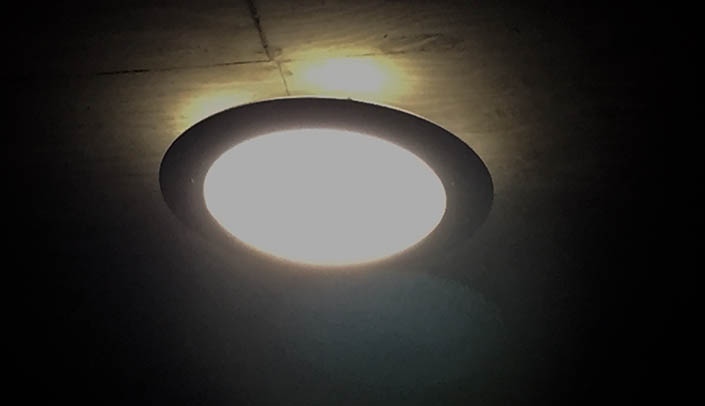Have you seen any of the new LED lights on campus? They are replacing the old fluorescent and metal halide fixtures, with dramatic results.
You likely have heard that LED bulbs save energy and already may have converted bulbs in your house. The same is true at the med center.
But how much are we really saving?
First, terminology. Lightbulbs are often sold by wattage, and we’ve learned to associate that with light, for example, a 40-watt bulb for a lamp, a 75-watt bulb in the kitchen. It’s true, but it’s actually a measurement of the amount of energy you are using. A 75W bulb uses 75 watts of electricity, but puts off about 1,100 lumens of light. (Lumen, from the Latin lumen, meaning light/window. “Lumos” from Harry Potter makes a lot of sense now, right?)
LEDs emit lumens using substantially less watts. The light comes from small diodes, so they are easily dimmable and emit less heat thereby reducing cooling costs.
Now, back to the savings. Lot 50, the parking garage south of the Durham Outpatient Center, recently had all 498 fixtures converted to LEDs. The size of that garage, combined with the fact that it is used 24/7, meant those lights were on 8,760 hours a year.
Switching to LEDs results in an annual energy reduction of 750,601kwh. That’s enough energy to power 70 average U.S. homes. It also will save the med center approximately $48,000 per year in electricity while reducing pollution created by burning coal — and that’s just one parking garage.
The med center is taking advantage of an OPPD rebate program and using the realized energy savings to purchase more LED fixtures to continue the savings.
“While those savings are impressive, it doesn’t stop there,” said LED project manager Brian Dykstra. “In addition to heat-load savings, LEDs can last up to 25 times longer, so we save on the maintenance costs of replacing lightbulbs. While that may sound trivial, it really adds up on a campus this size.”
This is especially true when bulbs are in a vaulted ceiling like an auditorium, or always-busy spaces like an operating room or patient room. Greater control of the system also allows daylight harvesting and motion-sensing, so lights are only on when they need to be.
LEDs will continue to be installed, based on total building use and install schedules, but you’ll be happy to know that all new buildings and remodeled spaces will have LEDs.

I never knew about the difference in regards to dollars saved!! WOW Something to consider in our own homes! Thanks for the information. Very much appreciated.
So how many watts does it take to produce 1100 lumens?
Those savings for just one parking garage are astonishing! It would be interesting to compare the environmental impact of the manufacturing process between LED, florescent, halogen, and metal halide. Perhaps in another article? Thanks!
Walt,
It depends on the bulb. An incandescent bulb uses around 75 watts to put off 1100 lumens. To get the same number of lumens in a CFL, it would use 20 watts, and for an LED it's about 9. (There is a little fluctuation in the watts on LEDs depending on the manufacturer). LEDs tend to put off a better quality light, last significantly longer, and don't have the UV light that can fade finishes, making them a better choice than CFLs.
This is a standard conversion for a bulb, that would be in your house. It's worth noting here that because of the amount of time they run and their purpose of use our fixtures are different. The diodes ("D" in LED) are board mounted in, which makes them slightly different.
I hope that helps,
Melanie